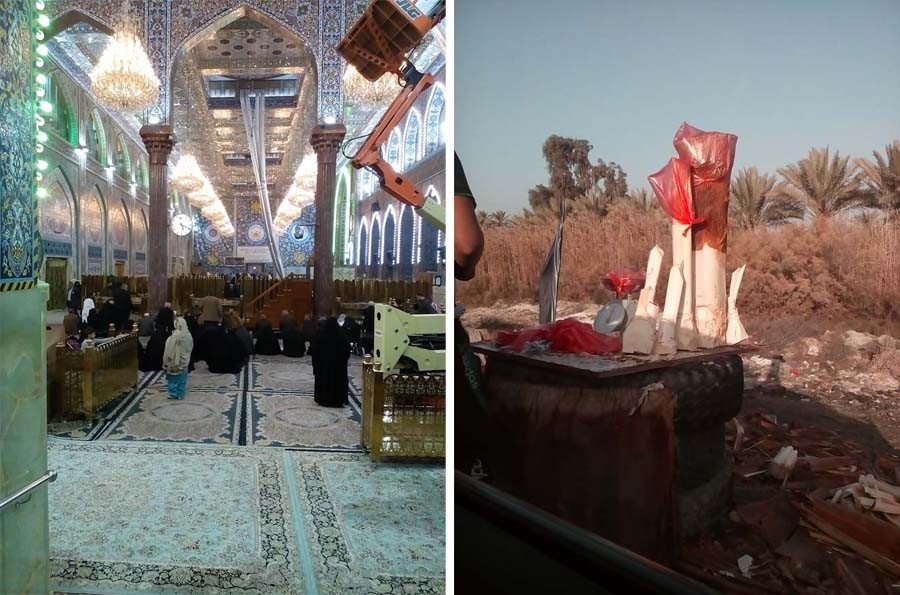
First time in the land of Kufa and Karbala to fulfill the cherished desire to visit shrines

As the airplane lowered over Baghdad, after almost four and a half hour flight from Karachi, I could see a landscape scattered with date trees and small and big, mostly single-storey houses. The risk of the unknown and uncertain gripped me upon landing in Baghdad. My cherished desire to visit the shrines of Iraq was about to be fulfilled, facilitated by my friend and student, Brig Arshad (retd).
The Baghdad airport, like majority of the important buildings built during the rule of Saddam Hussain, is solidly built, but compared to many modern airports of the Middle East, Baghdad International Airport, previously called Saddam International Airport, is small.
The Pakistan embassy vehicle picked us. Vehicles must be registered with the administration to reach airport from the city and its vicinity. The 15-km distance from the city to the airport is covered in two shifts. Passengers on a non-registered vehicle are offloaded at a security point for a body and luggage checkup. They are boarded again on buses taking them to the airport at a distance of 3km. Sniffer dogs also search the registered vehicles. It is time consuming and a nuisance at most times.
Iraq is a security state. Traffic is subject to checkups in all parts of the country. Still, locals say the security situation particularly in the last two years has improved drastically. A majority of developments in Iraq today were built during the Saddam Hussein rule. Most people I interacted with blamed the US for ruining their country.
My stay was at the monastery of Hazrat Abdul Qadir Gilani. The U-shaped, double-storey monastery was built by Saddam Hussein between 1990-96 to impart teachings in Sufism. There are a total of 223 rooms, small and big, which serve this purpose. The tomb of the saint was also renovated and covered with silver grills and domes. People visit the shrine from far and wide each day. It is crowded on Fridays and anniversaries.
Baghdad is big and splendidly built with spacious roads and boulevards. The old Baghdad comprises narrow streets and small shops. Many of the shrines I visited were either inside mosques or houses. But the Ministry of Shrines and Holy Sites strictly regulates them. Those living in the houses are bound to take care of them and keep them open for visitors and researchers.
The important shrines in Baghdad include Kazmeen Sharifs where two Imams -- Musa bin Jafar and Jawad bin Reza - are buried, and those of famous Muslim philosopher -- Ghazali, Mansour Hallaj, Junaid Baghdadi and Maruf al Kirkhi. The burial place of Hazrat Salman Farsi is at 20km from the city. A companion of the Prophet (pbuh) and son of Iman Bakir are buried in the compound of the shrine.
The distance between Baghdad and Karbala is 103km but usually it takes more than three hours due to security check posts on the way. I counted around eight posts belonging to army and police separately. Police is an important force in Iraqi cities. I found the policemen very polite and so were people I interacted with.
Karbala is a beautiful city with nice hotels and restaurants. It is also where the shrines of Hazrat Hussain and Hazrat Abbas exist at a close distance from each other. Not too far is the branch of river Euphrates from where Hazrat Abbas, in quest to fetch water for women and children during the battle, got wounded.
About 80km away is another historic city of Najaf. The shrine of Hazrat Ali is of prime attraction for visitors and pilgrims. It gives a splendid but simple look. Each day, it attracts pilgrims from Iraq and different parts of the world. What looked like a common scene at the shrine was carrying of coffin caskets, entering from one gate and exiting from another. Funeral prayers are held outside in the adjoining Imam Ali Mosque.
Najaf looks ancient, with graveyard Wadi us Salam spread over miles. It is the world’s largest graveyard. Najaf is also famous for Dur e Najaf and Dur e Hadeed, gemstones that people believe provide spiritual healing.
People visit the nearby city of Kufa to pray at two mosques of Kufa and Al Sahlah, not more than a kilometre apart from each other, and to visit Hazrat Ali’s house which he occupied during his rule. Ali was martyred in the Kufa mosque.
Hotels in Kufa are comparatively inexpensive than Karbala and Najaf. Most of the Pakistanis visiting Iraq prefer to lodge and board in Kufa. It was interesting to see tea walas sell their milky ware cooked on coal. One such tea stall vendor asked me to pay in Pakistani rupees. Also, outside in the bazaar, money changers can change Pakistani rupees into Iraqi dinars.